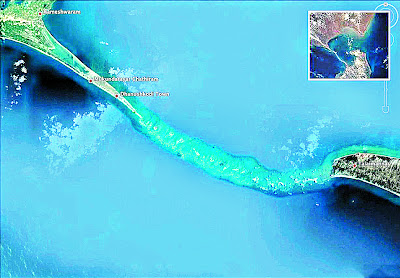The proposed Sethusamudram project is back in the eye of the
storm after its opponents have gone ballistic in their objection, with the
issue rocking the Parliament.
The BJP is leading the charge on behalf of various Hindu
groups who claim that the submerged land formation is what’s left of the bridge
built under the supervision of Lord Ram to facilitate his invasion of Lanka.
The saffron brigade is stubborn in its stand that damage to the ‘holy’ bridge
is unacceptable, and their credo has backers in legal luminaries like
Subramanian Swami — who are capable of keeping the project tangled in judicial
knots forever.
The project faces stiff opposition from local fishing community,
who say the present alignment would destroy marine life and corals. There are
also concerns raised by some experts about creating an artificial breach in a
natural barrier capable of buffering tsunami waves, thereby preventing
extensive damage to the entire southern coast.
A government-appointed committee headed by Rajendra K
Pachauri recently released its report terming the proposed project unviable
from ecological and economic aspects — but the Centre has decided to reject it
and go ahead.
Some say Sethusamudram Canal will provide India with the
benefits akin to those provided by Panama Canal or Suez Canal — though the
reality is that neither the distance reduced, amount of traffic, nor time saved
is anywhere in that scale. It must also be noted that the 12 metre-deep channel
cannot be used by ships above 30,000 tonnes. This would rule out most big
container ships, let alone massive crude carriers. And when one considers the
massive dredging costs, part of which will be recurring, things look less promising.
However, some are of the opinion that the advantage of
reduced distance is dwarfed by strategic concerns. It would ensure better
security for cargo and more effective monitoring by security agencies. The
added benefit would be that smaller ports in Kerala and Tamil Nadu will see
more business, and in turn, revenues.
In 2007, after filing an affidavit in the Supreme Court, the
Archaeological Survey of India (ASI) came under heavy criticism for questioning
the authenticity of Ram-built-it-theory. The officials, rather candidly,
pointed out that mythology cannot be the basis of government policy. All hell
broke loose in the land of the holy cow: the officials were suspended,
‘objectionable’ passages removed and the then law minister HR Bharadwaj smoothened
ruffled feathers by accepting the historical and cultural relevance of Ram.
We have the dubious distinction of the highest level of
judiciary entertaining cases where God is made a party... such periods in
Europe are now known as Dark Ages.
Since we are a nation where people take offence at the drop
of the hat, the mythological angle should be left out in the case of
Sethusamudram project. Hardly any opinion can be made on any topic under the
sun without offending someone or the other. And soon cases will follow for
“offending the sentiments” of X community, Y caste, Z interest group and XYZ
people who want their 15 minutes of fame by getting their names published in
news reports for filing cases.
Allowing development issues to be hijacked by political and
communal elements with vested interests would not only create divisions, but
also open floodgates of questionable methods to stall anything and everything.
Reason, and not religion, alone should decide public policy.
(This article was published as the editorial column in
Postnoon on February 27, 2013.)





